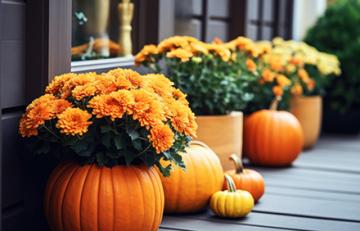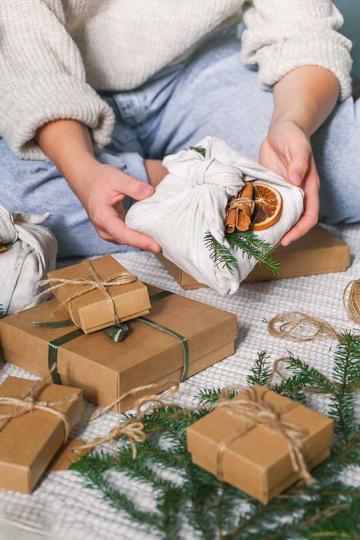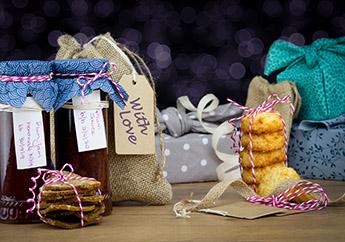Division of Environmental Quality Director: Art Goodin
Holidays are a special time of year for families and friends to gather and celebrate. In the excitement, it is easy to forget about the waste we produce. During the holidays we tend to overuse energy resources and create unnecessary food and trash waste. Here are some tips to maximize your holiday cheer while also being environmentally friendly.
Fall Holidays

Fall and Halloween usher in the year's first opportunities or grand decorations, over the-top costumes and lots of sweets. It is also the perfect opportunity to let your creative light shine! When it comes to costumes, think outside the (storage) box. Maybe some of the old clothes you have could be used for a creative costume. Old items around the house can also be used for costumes and accessories.
For some, fall and Halloween decorations are what the season is all about. If you really plan, you can grow your own gourds and pumpkins to accent your fall decor or buy them locally from a pumpkin patch. When the season is over, just add the gourds and pumpkins to your compost bin. To add a little green to the traditional orange and black decorations, go through your old clothes and other items you have hidden in boxes and the back of your closets. You can make an instant scarecrow for your front porch by stuffing old clothes with outdated newspaper or children’s school papers that would otherwise be thrown away.
If you plan to celebrate with a party, consider sending electronic invitations to reduce paper waste. Use reusable flatware, silverware and cloth napkins to serve your party food. If using reusable products isn’t possible, use paper plates and napkins with recycled content and biodegradable plastic cups that can be composted. To avoid using more cups than necessary, have guests label their cups with a marker or a holiday label. With a bit of effort, you can help the environment and save a little money in the process.
Video - Tips to Make Your Halloween Green
Winter Holidays
According to the U.S. Environmental Protection Agency, more than one million extra tons of waste per week are thrown in landfills across the United States between Thanksgiving and New Year's Day. This extra waste comes from food waste, packaging and trashed items replaced by newer versions received as gifts. Careful planning before and after the holidays can reduce the amount of related waste that ends up in Missouri's landfills.
When it comes to gift giving, consider the following options:

- Re-gift previously unopened gifts or give a homemade gift.
- Reuse glass jars by creating homemade snow globes or filling them with cookie and cake mixes. Instructions are available on the Internet.
- If you purchase gifts, consider environmentally friendly options such as cloth napkins and tablecloths, cloth shopping bags, gift certificates, lamps designed for compact fluorescent bulbs, lunch boxes, recycling bins or personalized stationary made from recycled paper.
- Purchase gifts with minimal packaging so there is less to throw away.
- If your gift requires batteries, buy rechargeable batteries. When wrapping your gifts, reuse holiday wrapping paper or gift bags from last year.
- Get creative and wrap your gifts with maps, posters or colored-in comics from your newspaper. You can also put gifts in decorative tins or boxes instead of throwaway wrapping materials.
- Prevent food waste by providing smaller plates and encouraging your guest to love their food and not waste it. After the party, compost as much food scraps as possible.
- Instead of buying a cut Christmas tree, consider a potted tree that can be replanted outside after the holidays. If you want a cut tree, buy from a local tree farm. By shopping locally, you help reduce the amount of fossil fuel used to transport the tree long distances to your local tree lot.
- Choose light-emitting diode LED Christmas lights, which have a longer life span and use less energy than regular lights. Use a timer so your lights are only on when needed. Recycle your lights at electronic recycling locations across Missouri or at one of these Christmas Light Collection Locations. Not all locations are open to the public.
- String popcorn around your tree and then place it in your yard afterward for the birds to eat. Be sure to remove the popcorn from its string so that birds and other animals don't get tangled in it.
- Make homemade ornaments from pine cones and fabric scraps. Create paper snowflakes with paper you would normally have thrown away. Use these same ideas to decorate your home and yard.
- Crafts with cardboard, Popsicle sticks, old calendar photos and old holiday cards make fun activities for kids and adults alike.
- After the holidays, the cleanup process begins. Compost as much of the food waste as possible and recycle as much as you can.
- If you or someone in your family received a new electronic device and you are not sure what to do with the old one, remove the batteries before disposal and visit Electronics to find environmentally friendly options available to reuse or recycle your old device. For information about recycling rechargeable batteries, visit Call2Recycle. Collection sites for used batteries are often available at Walmart, Batteries plus Bulbs, Radio Shack, Target, Sears, Black and Decker, Best Buy and Home Depot.
- Carefully pack up your decorations for reuse next year and recycle anything that has reached its end of life.
- If you bought a cut tree, it can be recycled too. The most popular method is chipping the trees to be used for mulch, but it can also be turned into a fish or wildlife habitat. Plant a new tree next spring to replace yours or someone else's Christmas tree that was harvested this season.
- Most importantly, prevent waste at the source and enjoy a truly earth friendly holiday season.
Video - Treecycling: How to Properly Dispose of Christmas Trees
Valentine's Day

The most traditional gift on Valentine's Day is a bouquet of flowers. After these flowers dry up, they are often thrown away and end up in a landfill. Call a local florist and ask if they have organic or fresh flowers, trees or shrubs that can be replanted in the spring. If you do receive a traditional flower arrangement, add them to your compost bin instead of throwing them out with the trash.
If you are looking for a creative gift idea, there are plenty of great projects on the internet. Bake cookies or make homemade candy and package them in a decorated reusable or recycled container. Give the gift of memorable experiences, such as tickets to a movie, concert, Missouri state park or a sporting event, all which provide the added benefit of spending more time with your loved one. You could also give a gift to a spa or a favorite store.
If you would rather purchase an item, look for gifts made from recycled materials. Invest in e-cards or greeting cards made with recycled paper or ones that can be easily recycled. For clothing, look for fleece jackets, pants and scarves made from recycled water and soda bottles. There are kitchen utensils and house décor made from recycled plastic and glass. Whatever you choose to purchase, you can even make the trip to the mall or store more environmentally friendly by carpooling with friends and bringing your own shopping bags.
Make dinner at home and eat by candlelight. Not only is it romantic, but it can save a little electricity by turning off the lights. If you would rather have a romantic dinner at a favorite restaurant, walk if it's a short distance away or take mass transit.
St. Patrick's Day
You don’t have to be Irish to enjoy St. Patrick’s Day, which is traditionally the “greenest” day of the year. Transportation accounts for a large chunk of all greenhouse gas emissions. If you plan to celebrate St. Patrick’s Day at one of the many parades or events held throughout Missouri, consider walking or bicycling if it’s close. If you live too far away, consider taking a bus or carpooling with friends. Carpooling and mass transit are great ways to be environmentally friendly, by reducing energy use and saving money in your wallet.
If you plan to celebrate St. Patrick’s Day with a party, you can leave an eco-friendly stamp on your event by purchasing reusable decorations or decorating with recyclable materials. If planning a traditional meal of corned beef and cabbage and a steaming bowl of potatoes, look for locally raised and packaged beef and be sure to compost the leftover cabbage and potato peels after your meal. You can also invest in ugly vegetables, the appearance may be unpleasant, but they still taste great. For a truly eco-friendly St. Patrick’s Day gift, give friends and family a potted shamrock. They make a wonderful indoor houseplant and are believed to bring good luck.
Summer Celebrations
When you think of Memorial Day, Independence Day, Labor Day or other summer activities, most people celebrate by pulling out the grill and having a barbecue. You can make grilling environmentally friendly by making a few changes to the way you grill:
- Propane gas grills burn cleaner, but if you prefer a charcoal grill, look for lump brands made from sustainable forest timber. For the more extreme "eco-friendly griller," solar powered grills are gaining popularity. These grills amplify the sun's rays just enough to grill those burgers, brats and dogs. They take a little longer to heat up, but leave almost no environmental impact, except the smell of sizzling barbecue.
- If the fire needs a little help getting started, use a chimney starter rather than lighter fluid to get it going. This cuts down on chemicals released into the air.
- When it comes to choosing what to cook on your grill, visit your own garden or local farmer’s markets for fresh produce, and look for locally raised and processed meat. By shopping locally, you help reduce the amount of fossil fuel used to transport food long distances to your local grocers while supporting your local economy.
- When setting the table, use reusable flatware, silverware and cloth napkins. For a unique look, you can use bandanas for napkins and old quilts for tablecloths. If using reusable products isn’t possible, use paper plates and napkins with recycled content and biodegradable plastic cups that can be composted.
- After dinner, compost as much of the food scraps as possible and enjoy the outdoor weather, no air-conditioning required.
Nothing in this document may be used to implement any enforcement action or levy any penalty unless promulgated by rule under chapter 536 or authorized by statute.
For more information
Waste Management Program
Division of Environmental Quality
P.O. Box 176
Jefferson City, MO 65102-0176
United States
